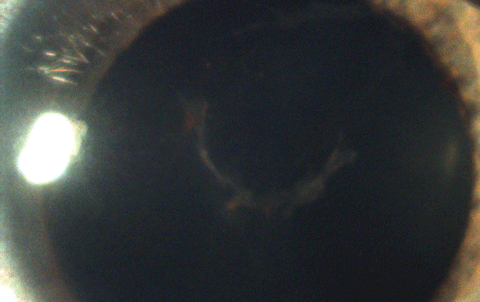
Q:
I have a patient with moderate anterior uveitis in one eye. Not only has there been no improvement after a week of Pred Forte (prednisolone acetate, Allergan) QID, but now it looks like he is developing posterior synechiae. Where do I go from here?A:
Anterior uveitis can be a formidable foe. “One should not take this disease lightly,” says Trennda L. Rittenbach, OD, of the Palo Alto Medical Foundation in Sunnyvale, California. Aggressive treatment is necessary, she says, to lower the risk of consequences such as trabecular meshwork damage and glaucoma, among others.
In mild cases, initial treatment with time-honored prednisolone may suffice. However, if the patient does not respond to Pred Forte, Dr. Rittenbach advises calling in the big guns. “I would switch them immediately to Durezol (difluprednate, Alcon) along with dilating agents,” says Dr. Rittenbach, noting that it is uncommon for synechiae to develop if the patient is on a cycloplegic agent. “Unless the anterior uveitis is very mild, my go-to regimen is Durezol QID to Q2H and cyclopentolate 1% BID,” says Dr. Rittenbach. “And, if the iritis is severe, I will add Tobradex (tobramycin/dexamethasone, Alcon) ung qHS.” She notes that the steroid ointment at night will give the patient coverage for those hours they are sleeping, to avoid having them wake up in the middle of the night to instill drops.
Dr. Rittenbach says that, as a reminder, the physician needs to monitor for a steroid response at every follow-up appointment. If frequent topical dosing isn’t controlling the inflammation, think about a methylprednisolone dose pack or subconjunctival steroid injection.
“Blast Away” Posterior Synechiae
If synechiae have developed, the best approach, according to Dr. Rittenbach, is what she calls the blasting technique. “I soak a Weck-Cel sponge in a mixture of 1% atropine and 10% phenylephrine. After giving a drop of proparacaine to the eye, I place the sponge in the inferior fornix, where it remains for about 10 to 15 minutes with the eye closed,” says Dr. Rittenbach. She says that she may see some of the synechiae break that day, but more often will see the greatest results the following day. “Don’t be afraid to prescribe the atropine and 10% phenylephrine for advanced cases, BID to QID; but, you should probably have these drops on hand, as most pharmacies don’t carry them.”
Also, remember to use caution with 10% phenylephrine in patients with any heart problems, she says, due to their rare but serious potential cardiovascular effects, reminds Dr. Rittenbach.
Systemic Work-up—Must-Do
In the past, I would do a systemic work-up for anyone with bilateral or recurrent uveitis, Dr. Rittenbach says. “Now, I have a lengthy discussion about the possible underlying causes of uveitis and offer a systemic work up to patient for the first occurrence of an anterior uveitis. I also go over the patient’s medical history and ask questions about any joint or back pain and take a thorough family medical history.”
 |
| This patient will require aggressive management to break their synechiae. Click image to enlarge. |
It is extremely important to control any underlying systemic disease that is giving rise to inflammation in the body. To investigate this, one has to order the systemic work-up. “It is also a great idea to establish a relationship with a rheumatologist to refer these patients to if necessary,” says Dr. Rittenbach.
What Goes Up, Must Come Down
A patient on an aggressive steroid regimen can expect to see relief quickly. But don’t be in a rush to taper once the presentation is under control. A steroid taper differs between patients, says Dr. Rittenbach. There is no set-in-stone protocol to follow. “It depends on how well an individual patient responded to the treatment and how long they have been on the steroid.” Just remember—a slow taper is best to avoid a rebound; also, continue to measure the IOP at every visit.

